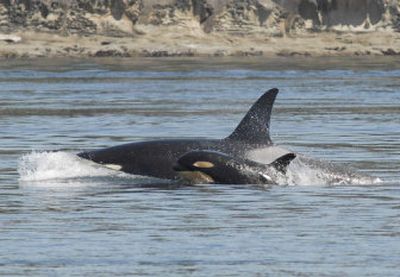Three missing orcas feared dead

SEATTLE – Three young adult killer whales – members of the family groups that spend their summers chasing salmon around Washington’s San Juan Islands – have not been seen in weeks and are feared dead, researchers said Tuesday.
One of the orcas leaves a 4-month-old orphan, whose care apparently has been taken over by another female.
The three salmon-eating orca families that frequent the state’s inland waters are J, K and L pods. J-pod spends virtually the entire year in the waters north of Puget Sound, while the other two groups head out to the open ocean in winter.
The pods, called the southern resident population, are unique in diet, language and DNA, and were declared an endangered species last year, with a recovery goal of 120 animals. If the three missing whales have died, the three pods will total 87 orcas, with just 23 reproductive females.
The missing mother, K-28, is from K-pod, said Kelley Balcomb-Bartok, a research assistant at the Center for Whale Research in Friday Harbor, which tracks the pods and maintains photo-identification records of each animal.
A photo of K-28 taken Sept. 19 shows a dip behind her blowhole, which indicates illness or malnutrition, he said. The 12-year-old female may also have had difficulties related to the birth.
K-28 has not been seen since, though researchers have had other encounters with the group and have seen her calf swimming close to other family members. Her baby, K-39, likely is being cared for by an older female, her aunt, K-22, Balcomb-Bartok said.
Orcas are not fully weaned until about age 2, and researchers worry the calf, described as “healthy and precocious,” may not survive the winter.
The two other missing orcas are from L-pod: L-43, 34-year-old mother of three last seen Sept. 2; and L-71, a 20-year-old male last seen July 15 despite 25 encounters with L-pod.
“We’ve spent weeks searching for these individuals, we’ve spent weeks waiting,” Balcomb-Bartok said.
Since the two pods leave the state’s sheltered waters for much of the year, “Our concern is the coast – what’s out there?” he said. “Are there salmon runs they used to rely on that are reduced dramatically? … Maybe in some areas they either are no longer available or they’re in such short supply they’re not sustaining the population.”
Many of the region’s salmon runs also are listed as endangered or threatened, their numbers down to about 10 percent of historical highs.
While orca calf survival rates have been problematic for years, “losing adults is cause for concern,” Balcomb-Bartok said. He noted an earlier death to illustrate the risks: “When J-18 washed up off Vancouver Island several years ago he was sterile, and a high level of toxins had eaten their way through his system.”
Whale experts worry about the effects of pollutants such as polychlorinated biphenyls, or PCBs – an industrial product banned since the 1970s but persistent in the environment – and fire-retardant polybrominated diphenyl ethers, which are still produced.
“All those big boys,” Balcomb-Bartok said. “Things that are insidious in the environment as a whole.”
Federal action in response to the orca’s endangered listing is still being decided. The National Marine Fisheries Service has proposed declaring as critical habitat virtually all the state’s inland waters, except shorelines where water is less than 20 feet deep and areas near military installations.
Developers and agricultural interests have already challenged the draft proposal in federal court, contending the whales are part of a larger healthy population and do not warrant special protections – a stance initially taken by NMFS but reversed by a federal judge whose ruling led to the current listing.